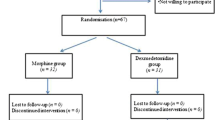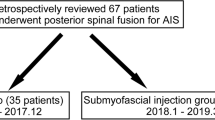Summary. One hundred adolescents undergoing posterior spinal fusion for scoliosis were reviewed to assess the adequacy of postoperative patient-controlled analgesia. There were 94 females and 6 males. The mean settings for morphine dosage were a loading dose of 114.5 μg · kg –1
, a bolus dose of 24.8 μg · kg–1, and a lockout interval of 9.9 minutes. This was used for an average of 75.8 h, with a 52.2% success rate. Adolescents using patient-controlled analgesia showed a great variability in morphine requirements with greater use as they became older. The requirement was not significantly different on the 1st, 2nd and 3rd postoperative days and the total consumption was 52.2 μg · kg–1· h–1. Nausea and vomiting occurred in 45% and pruritus in 15%. There were 7 cases of respiratory depression who all recovered promptly and completely. This method is associated with high morphine requirements in adolescents, but can be used safely.
Résumé. Nous avons étudié rétrospectivement l’utilisation de l’analgésie contrôlée par le patient (ACP) chez 100 adolescents ayant subi une chirurgie de correction de scoliose idiopathique. Quatre-vingt-quatorze adolescentes et 6 adolescents, de 11 à 19 ans, ont été inclus dans cette étude. La programmation de la pompe d’ACP pour la morphine était la suivante: dose de charge 114.5 μg · kg –1
, bolus de 24.8 μg · kg–1 et intervalle entre deux injections de 9.9 minutes. L’ACP a été utilisée en moyenne pendant 75.8 heures, et le pourcentage de demandes satisfaites était de 52.2. Les besoins en morphine délivrée par l’ACP, ont été très variables, avec une tendance vers des besoins plus importants avec l’âge. Les besoins en morphine n’ont pas été significativement différents durant les trois premiers jours postopératoires, et la consommation moyenne de morphine pendant cette période a été de 52.5 μg · kg–1· h–1. Les nausées et vomissements ont été rapportés chez 45% des adolescents, contre 15% pour le prurit. Nous avons enregistré 7 cas de dépression respiratoire, mais tous les patients ont récupéré rapidement et complètement. L’utilisation de l’ACP chez l’adolescent après chirurgie orthopédique majeure est associée à des besoins importants en morphine, mais reste sécuritaire.
Similar content being viewed by others
Author information
Authors and Affiliations
Additional information
Accepted: 14 November 1995
Rights and permissions
About this article
Cite this article
Beaulieu, P., Cyrenne, L., Mathews, S. et al. Patient-controlled analgesia after spinal fusion for idiopathic scoliosis. International Orthopaedics SICOT 20, 295–299 (1996). https://doi.org/10.1007/s002640050081
Issue Date:
DOI: https://doi.org/10.1007/s002640050081




